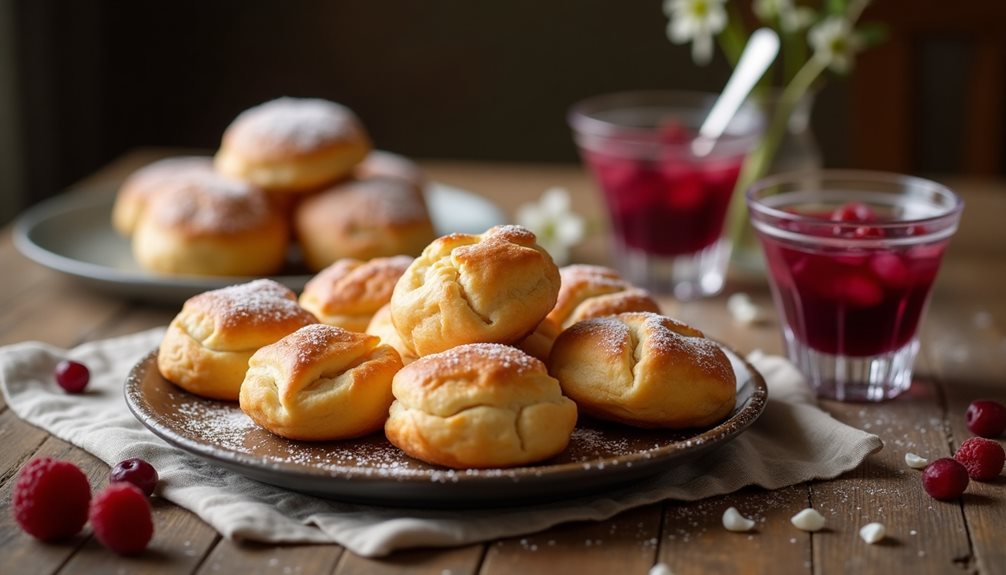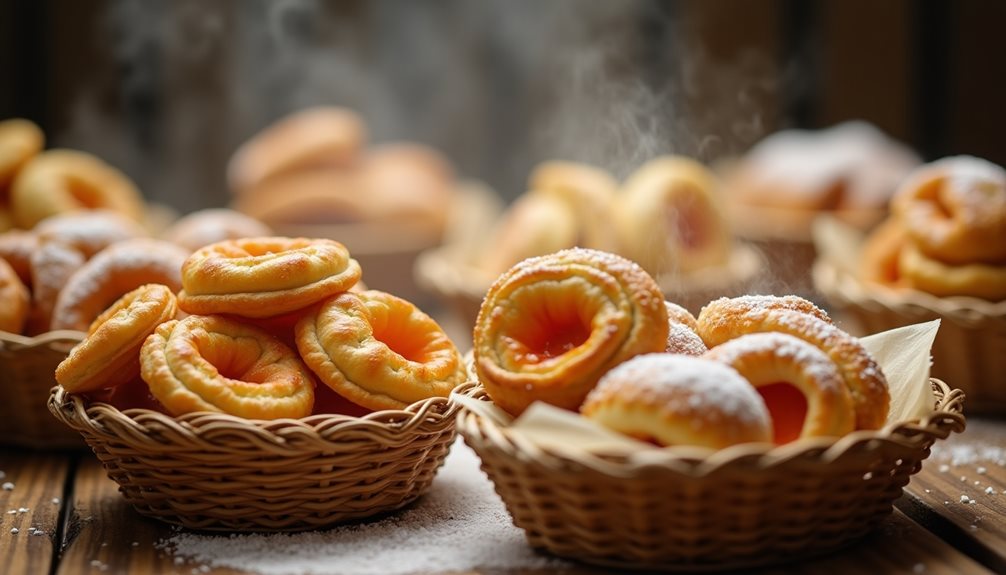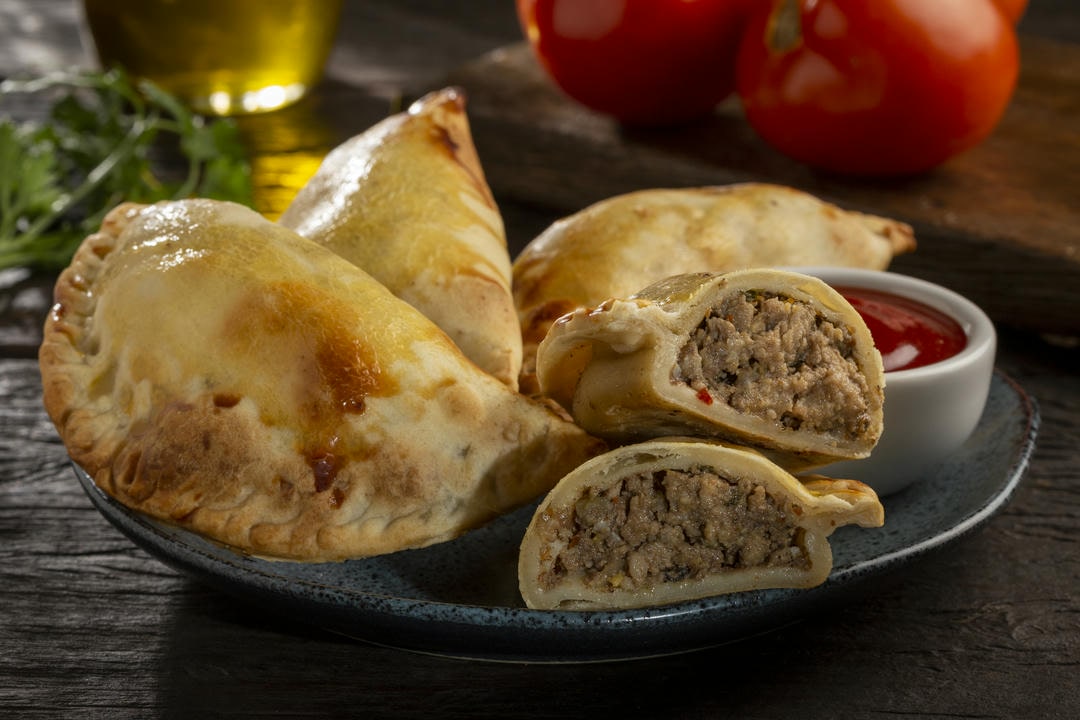Russian pastries offer a captivating journey through the country’s rich culinary heritage, where each treat, from pirozhki to kurnik, embodies the essence of regional flavors and historical significance. These baked goods are more than just sustenance; they are symbols of cultural identity, weaving together generations through shared traditions. With a delightful array of textures and fillings, they beckon you to explore their depths. These delectable creations hold stories of tradition and evolution, reflecting the dynamic history of Russian cuisine. As you indulge in these treats, you’ll discover the intricate tapestry of flavors and customs that have shaped them over time.
Introduction

Russian pastries offer an enchanting blend of flavors and traditions, reflecting the country’s rich cultural heritage. These delightful confections emerge from traditional techniques passed down through generations, showcasing regional variations that celebrate local ingredients and seasonal offerings. Each pastry carries its own symbolism, often tied to cultural rituals or significant occasions.
From the buttery layers of Napoleon Cake to the hearty pirozhki, each creation is a testament to the artistry of baking rituals that unite families and communities. As visitors indulge in these treats, they experience a narrative filled with history, creativity, and shared joy.
Culinary Diversity
Exploring Russia reveals a culinary landscape as diverse as its geography, reflecting the myriad influences that have shaped the nation over centuries. Russian cuisine, steeped in rich heritage, showcases regional diversity from the hearty dishes of Siberia to the delicate flavors of the Black Sea coast. Historical influences, including Mongol, Tatar, and European exchanges, have enriched Russian cuisine, leading to modern adaptations that cater to contemporary palates.
This complexity highlights Russia’s internal diversity and underscores the global significance of its culinary practices, inviting appreciation from food enthusiasts worldwide.
Baked Goods in Culture
Baked goods hold a cherished place in Russian culture, serving not only as sustenance but also as symbols of community and tradition. Enriched with cultural symbolism, these pastries embody various pastry rituals that connect generations. Seasonal variations showcase the bounty of nature, with distinct regional specialties reflecting local ingredients and flavors. From everyday snacks, like pirozhki filled with seasonal vegetables, to extravagant festive treats such as kulich during Easter, baking traditions resonate deeply within Russian life.
Each bite tells a story of history, resilience, and the shared joy of gathering around the table.
Belyashi: The Meat-Filled Delight

Belyashi, golden fried pastries filled with savory minced meat, are a beloved staple of Russian street food. Typically prepared with beef or lamb mixed with onions for added flavor and juiciness, these treats trace their origins to Tatar cuisine, where they are traditionally known as peremech. Their distinctive preparation involves wrapping unleavened or yeast dough around the filling and frying until crisp and golden.
What sets belyashi apart is their unique shape, often featuring a small circular “window” at the top that exposes the meat filling. This design not only adds visual appeal but also enhances the cooking process by sealing in the juices. Modern variations may omit the “window” or incorporate regional spices and herbs, showcasing the adaptability of this iconic dish across Russia.
Culinary Evolution and Cultural Significance
Originally rooted in Tatar culinary traditions, belyashi have become a symbol of Russia’s vibrant street food culture and its history of culinary exchange. Over time, recipe adaptations have introduced innovations such as using kefir for a tangy dough or ice water to create a lighter texture. These enhancements highlight the creativity of home cooks and street vendors alike.
In Moscow, where diverse culinary influences converge, belyashi recipes often include pork alongside beef—an adaptation reflecting local preferences but diverging from traditional Tatar practices. Despite these variations, belyashi remain a nostalgic favorite for Russians, often evoking memories of long train journeys or family gatherings.
Whether enjoyed plain or paired with tangy sauces, belyashi offer a satisfying blend of crispy exterior and juicy filling that continues to delight food lovers across Russia and beyond. This cherished dish exemplifies the fusion of tradition and innovation within Russian cuisine, connecting generations through shared flavors and experiences.
Pirozhki: Russia’s Versatile Hand Pies

Pirozhki, small hand pies cherished in Russian cuisine, embody versatility and tradition. With roots stretching back centuries, these pastries are made from yeast-leavened dough and come in both baked and fried varieties. Their fillings range from savory options like cabbage, potatoes, mushrooms, and ground meat to sweet choices such as apples, berries, or tvorog (cottage cheese).
These hand-sized pies are a staple at family gatherings and festive occasions, symbolizing hospitality and warmth. Whether served fresh from the oven with sour cream or paired with tea for a comforting snack, pirozhki reflect the agricultural abundance of Russia and its culinary heritage.
Cultural Significance and Regional Variations
Pirozhki hold a special place in Russian culture, connecting generations through shared recipes and traditions. Their preparation often showcases regional diversity—some variations include spices or herbs unique to local customs. For example, rasstegai, a type of open-topped pirozhki traditionally filled with fish, highlights the creativity of Russian baking techniques.
During the Soviet era, fried pirozhki became a popular street food, found at bustling markets and train stations across the country. Today, they remain a symbol of community and celebration, enjoyed everywhere from casual strolls to festive tables.
Culinary Innovation
Modern adaptations of pirozhki recipes demonstrate the ingenuity of cooks across Russia. Ingredients like kefir are sometimes used to create a tangy dough, while ice water can lighten the texture for an even more satisfying bite. These innovations ensure that pirozhki continue to evolve while honoring their deep-rooted traditions.
Whether enjoyed at home or on the streets, pirozhki exemplify Russia’s rich culinary diversity and enduring spirit of hospitality.
Kurnik: The Festive Royal Pies
Kurnik, often called the “royal pie” or “wedding pirog,” is a dome-shaped savory pastry that holds a special place in Russian culinary tradition. This elaborate dish, typically filled with chicken, rice, mushrooms, hard-boiled eggs, and onions, has been a centerpiece of festive occasions for centuries. Its origins trace back to southern Russia, particularly the Cossack territories, where it was prepared for weddings and other celebrations as a symbol of abundance and hospitality.
A Culinary Symbol of Tradition
Historically reserved for nobility, kurnik embodies the artistry of Russian pastry-making. Its preparation often includes intricate decorations sculpted from dough—flowers for brides symbolizing beauty and kindness, and figures for grooms representing strength and unity. Some recipes incorporate layers of blini (thin pancakes) between the fillings to enhance flavor and texture. The pie’s golden crust and fragrant filling make it a feast both for the eyes and the palate.
Regional Variations and Modern Adaptations
Regional differences in kurnik recipes highlight the diversity of Russian cuisine. In Ryazan, kurniks are sometimes made with rye flour and whole chickens baked inside, while other variations use puff pastry or cream cheese-based dough for a lighter texture. The pie’s shape may vary from round to rectangular depending on local traditions. Despite these differences, its essence remains unchanged—a dish that celebrates communal joy and cultural heritage.
A Timeless Culinary Treasure
Whether served at weddings, Easter feasts, or family gatherings, kurnik continues to enchant with its rich flavors and historical significance. Cutting into the pie reveals layers of savory ingredients, releasing an aroma that captures the essence of festive Russian cooking. As both a culinary relic and a modern favorite, kurnik stands as a testament to Russia’s vibrant food culture and enduring traditions.
Sochniki: Cottage Cheese Classics
Sochniki, semicircular pastries filled with creamy cottage cheese, are a cherished classic of Russian cuisine. These delights combine a tender, crumbly dough with a rich filling, offering a harmonious blend of textures and flavors. Their name derives from the Russian word sotschen, meaning “rolled-out dough,” reflecting their simple yet elegant preparation.
Origins and Nostalgia
The story of sochniki begins in Ancient Rus, where simple scones evolved into stuffed pastries filled with sour cream and tvorog, the Russian version of cottage cheese. Widely popularized during the Soviet era, they became a staple in school cafeterias and bakeries, symbolizing comfort and affordability. For many Russians, sochniki evoke fond childhood memories of family gatherings and festive occasions.
Culinary Craftsmanship
These pastries showcase regional diversity in Russia, with variations like the Arkhangelsk style featuring savory fillings and the Yaroslavl style favoring sweet ones. The dough is rolled thin and shaped into half-moons, often left slightly open to reveal the creamy filling. The delicate shortbread crust contrasts beautifully with the soft tvorog interior, creating a melt-in-your-mouth experience.
Cultural Significance
Sochniki are more than just desserts—they embody warmth, tradition, and shared moments. Whether served warm with tea or enjoyed as a snack, they carry the essence of Russian heritage. Their preparation is often a family ritual, with recipes passed down through generations.
Modern Appeal
Despite their historical roots, sochniki remain popular today. They can be found in stores across Russia but are best enjoyed homemade. Baking them allows for customization—adjusting sweetness or experimenting with fillings—and ensures their signature freshness.
How to Enjoy
Perfect for breakfast, dessert, or a midday treat, sochniki pair wonderfully with tea or coffee. Their versatility makes them ideal for parties or quiet moments at home. Stored properly in an airtight container, they retain their flavor for days—though their irresistible taste rarely lets them last that long.
In every bite of sochniki lies a connection to Russia’s culinary history—a celebration of simplicity, nostalgia, and craftsmanship.
Vatrushki: Sweet Cheese Buns
Vatrushki, round brioche buns filled with creamy cottage cheese, are a beloved staple of Eastern European pastry traditions. These sweet treats, enjoyed in Russia and beyond, captivate with their pillowy dough and luscious filling, often enhanced by hints of vanilla or lemon.
Origins and Cultural Significance
The history of vatrushki is deeply intertwined with Eastern European culinary heritage. Their name likely stems from the Old Slavic word vatra, meaning “fire,” as these buns were traditionally baked in wood-fired ovens. Over centuries, vatrushki have evolved into a symbol of hospitality and warmth, frequently served during family gatherings and festive occasions.
Culinary Craftsmanship
Vatrushki are made using a soft yeast dough that rises to perfection, creating a light and airy texture. The filling typically features tvorog (farmer’s cheese), mixed with sugar, eggs, and sour cream to achieve a creamy consistency. Some variations incorporate fruits like raisins or blueberry preserves for added sweetness and complexity.
The preparation involves shaping the dough into balls, pressing an indentation in the center to hold the filling, and baking until golden brown. The result is a delightful contrast between the fluffy exterior and the rich, creamy interior.
Regional Variations
While classic vatrushki feature sweet cheese fillings, regional adaptations showcase diverse flavors. In Western Russia, they may include tangy lemon zest or vanilla bean paste, while in Eastern regions, savory versions with mashed potatoes or herbs are popular. Some recipes even top the buns with streusel for added texture.
How to Enjoy Vatrushki
Vatrushki are versatile pastries that can be enjoyed at any time of day. They pair beautifully with tea or coffee and make for a comforting breakfast or snack. Adding fresh fruit or honey elevates the experience further.
A Timeless Connection to Tradition
Each bite of vatrushka tells a story of craftsmanship and cultural pride. Whether homemade or store-bought, these buns embody the rich mosaic of Russian culinary heritage—a blend of tradition and innovation passed down through generations. Their nostalgic flavors transport many back to cherished family moments, making vatrushki much more than just a sweet treat—they are a celebration of history and togetherness.
Ponchiki (Pyshki): Russian Doughnuts
Ponchiki, also known as pyshki, are a beloved treasure of Russian culinary tradition. These golden, sugary doughnuts are a perfect embodiment of indulgence and comfort, offering a crisp exterior that gives way to a soft, fluffy interior. Whether enjoyed at home or at iconic cafes like St. Petersburg’s Pyshechnaya, ponchiki have become a symbol of Russia’s warm hospitality and rich culinary heritage.
Origins and Preparation
The history of ponchiki is rooted in simplicity and tradition. These doughnuts are made by frying small rounds of yeast dough until perfectly golden. Their preparation techniques vary slightly across regions, but the result is always the same—an irresistible treat with a light, airy texture. Often dusted generously with powdered sugar, ponchiki are typically served warm alongside tea or coffee, creating a comforting ritual that transcends generations.
Regional Variations
While the classic ponchiki recipe remains universally adored, regional adaptations add unique flair to these doughnuts. In some areas, fillings like jam or condensed milk are added for extra richness, while others experiment with different dough recipes to create subtle variations in flavor and texture. These regional specialties reflect the diverse influences that have shaped Russian cuisine over centuries.
Cultural Significance
Ponchiki are more than just a sweet snack—they are deeply woven into the history of Russian culture. Often served during family celebrations or festive gatherings, they evoke feelings of warmth and togetherness. Their popularity in bustling urban cafes and quiet rural kitchens alike speaks to their universal appeal as a symbol of joy and indulgence.
Celebrating Russian Pastry Heritage
From the flaky layers of vatrushki to the pillowy softness of ponchiki, Russian pastries embody centuries of culinary craftsmanship and cultural pride. These treats are more than just food—they are vessels of history, tradition, and shared memories that connect generations through the simple joy of baking and sharing. As you savor each pastry, you’re not just indulging in sweetness; you’re experiencing the essence of Russia’s rich heritage—a celebration of warmth, creativity, and community in every bite.





